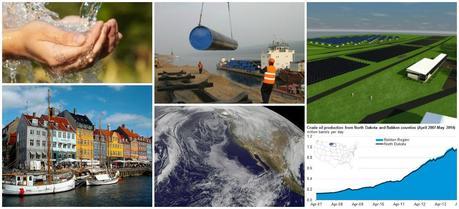
Here’s a bit of energy news that didn’t make it into our daily coverage during the past week. In this review, we collected some of less big, but nonetheless interesting news, of the week that went by, from the world of energy science and technology.
SEE ALSO: 8/1/2014 This Week in Energy: Beyond Headlines
Renewables
Work Starts at UQ Gatton on Australia’s Largest Solar PV Systems Research Facility
The University of Queensland and First Solar have begun construction on a 3.275 megawatt solar photovoltaic research facility at UQ’s Gatton campus.
Copenhagen to Be World’s First Carbon-Neutral Capital
While other countries debate whether to install wind turbines offshore or in remote areas, Denmark is building them right in its capital. Three windmills were recently inaugurated in a Copenhagen neighbourhood, and the city plans to add another 97
Solar Industry in California Generates More Jobs Than Energy Utilities
Wearing hard hats and bright yellow shirts, dozens of solar installers from across the state gathered at the State Capitol to call on policy makers to create jobs by cutting red tape through streamlined and standardized permitting. As more and more Californians go solar to control their electricity costs and help the state meets its climate goals, local governments can do their part by making it easier for their residents to navigate often-complicated permitting processes.
Energy Efficiency
Fuel Economy of New Vehicles Sold in U.S. Up Slightly Last Month
Fuel economy of new vehicles sold in the U.S. during July fell just shy of the all-time high, say researchers at the University of Michigan Transportation Research Institute.
Environment
Study of Aerosols Stands to Improve Climate Models
Of all the factors that influence Earth’s changing climate, the effect that tiny particles in Earth’s atmosphere called aerosols have on clouds is the least well understood. Aerosols scatter and absorb incoming sunlight and affect the formation and properties of clouds. Among all cloud types, low-level clouds over the ocean, which cover about one-third of the ocean’s surface, have the biggest impact on the albedo, or reflectivity, of Earth’s surface, reflecting solar energy back to space and cooling our planet.
Activities to Mitigate Greenhouse Gas Emissions Will Impact on Scarce Water Resources
As our new research published in Climatic Change shows, some activities aimed at tackling greenhouse emissions can also consume large amounts of water. In a water-poor country like Australia, this can make a real difference in the relative economic attractiveness of these strategies.
Oil and Natural Gas
Pipe Supply Starts for Power of Siberia GTS Construction
First pipes for the Power of Siberia gas transmission system (GTS) were delivered to Lensk (Yakutia). The first batch consists of 260 1,420-millimeter pipes with a 21.7 millimeter wall thickness and the total weight of some 2.4 thousand tons. The pipes are currently stocked at the temporary storage; they will be used for constructing the GTS section from the Chayandinskoye field to Lensk. All in all, in 2014 it is planned to deliver over 120 thousand tons of pipe products.
Energy Department Authorizes Oregon LNG to Export Liquefied Natural Gas
The Energy Department announced that it has conditionally authorized LNG Development Co., LLC (Oregon LNG) to export domestically produced liquefied natural gas (LNG) to countries that do not have a Free Trade Agreement (FTA) with the United States, from the Oregon LNG Terminal in Warrenton, Oregon.
Bakken Fuels North Dakota’s Oil Production Growth
North Dakota crude oil production surpassed 1.0 million barrels per day (bbl/d) in April and May (the latest data available). This record is the result of increasing crude oil production from the Williston Basin’s Bakken and Three Forks formations in North Dakota and eastern Montana.
Marcellus Region Natural Gas Production Continues Growth
Natural gas production in the Marcellus Region exceeded 15 billion cubic feet per day (Bcf/d) through July, the first time ever recorded, according to EIA’s latest Drilling Productivity Report. The Marcellus Region, mostly located in West Virginia and Pennsylvania, is the largest producing shale gas basin in the United States, accounting for almost 40% of U.S. shale gas production. Marcellus Region production has increased dramatically over the past four years, increasing from 2 Bcf/d in 2010 to its current level.

